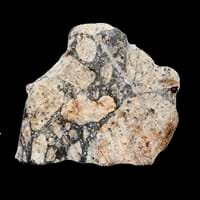Definition
Limestone is a sedimentary rock composed mostly of calcite and aragonite, which are different crystal forms of calcium carbonate
Breccia is a rock consisting of angular fragments of stones which are cemented by finer calcareous material
Origin
New Zealand
England
Discoverer
Belsazar Hacquet
Unknown
Etymology
From lime and stone in late 14th Century
From Italian, literally gravel, Germanic origin and related to break
Class
Sedimentary Rocks
Sedimentary Rocks
Sub-Class
Durable Rock, Medium Hardness Rock
Durable Rock, Hard Rock
Group
Not Applicable
Not Applicable
Other Categories
Fine Grained Rock, Opaque Rock
Coarse Grained Rock, Medium Grained Rock, Opaque Rock
Texture
Clastic or Non-Clastic
Brecciated, Clastic
Color
Beige, Black, Blue, Brown, Cream, Gold, Green, Grey, Light Green, Light Grey, Linen, Pink, Red, Rust, Silver, White, Yellow
Beige, Black, Blue, Brown, Buff, Green, Grey, Orange, Pink, Purple, Red, Rust, White, Yellow
Durability
Durable
Durable
Scratch Resistant
Yes
Yes
Appearance
Rough and Banded
Layered, Banded, Veined and Shiny
Interior Uses
Decorative Aggregates, Interior Decoration
Countertops, Decorative Aggregates, Entryways, Floor Tiles, Flooring, Homes, Hotels, Interior Decoration
Exterior Uses
As Building Stone, As Facing Stone, Garden Decoration, Office Buildings
As Building Stone, As Facing Stone, Paving Stone, Garden Decoration, Office Buildings
Other Architectural Uses
Curbing
Curbing
Construction Industry
Cement Manufacture, Cobblestones, for Road Aggregate, Production of Glass and Ceramics, Raw material for the manufacture of mortar, Roadstone, Source of calcium
As Dimension Stone, Construction Aggregate, Landscaping, Roadstone
Medical Industry
In Chemical and Pharmaceutical Industry, Medicines and Cosmetics
Not Yet Used
Antiquity Uses
Artifacts, Monuments, Sculpture, Small Figurines
Artifacts, Sculpture
Commercial Uses
Animal feed filler, As a Feed Additive for Livestock, Paper Industry, Raw material for manufacture of quicklime, slaked lime, Soil Conditioner, Used in aquariums, Whiting material in toothpaste, paint and paper
Creating Artwork, Gemstone, Jewelry
Types
Chalk, Coquina, Fossiliferous Limestone, Lithographic Limestone, Oolitic Limestone, Travertine, Tufa
Collapse Breccia, Fault Breccia, Flow Breccia, Pyroclastic Breccia, Igneous Breccia and Impact Breccia
Features
Host Rock for Lead, Stalactites and stalagmites are formed from this rock, Zinc and Copper Deposits
Available in Lots of Colors and Patterns, Clasts are smooth to touch
Archaeological Significance
Monuments
Used
Not Yet Used
Famous Monuments
Acropolis of Athens in Greece, Agia Sophia in Istanbul, Turkey, Al Aqsa Mosque in Jerusalem, Angkor Wat in Cambodia, Big Ben in London, Charminar in Hyderabad, India, Chhatrapati Shivaji Terminus in Maharashtra, India, Chichen Itza in Mexico, Empire State Building in New York, Khajuraho Temples, India, Kremlin in Moscow, Louvre in Paris, France, Neuschwanstein in Bavaria, Potala Palace in Lahasa, Tibet, Wailing Wall in Jerusalem
Not Applicable
Famous Sculptures
Ajanta Caves in Maharashtra, India, Elephanta Caves in Maharashtra, India
Data Not Available
Pictographs
Used
Not Used
Petroglyphs
Used
Not Used
Formation
Limestone is a sedimentary rock which is mainly made up of calcium carbonate.
Breccia is a clastic sedimentary rock which is composed of broken fragments of minerals or rock which are cemented together by a fine-grained matrix and it forms where broken, angular fragments of rock or mineral debris accumulate.
Mineral Content
Calcite, Chert, Clay, Dolomite, Quartz, Sand, Silt
Calcite, Clay, Feldspar, Phosphates, Quartz, Silica
Compound Content
Aluminium Oxide, NaCl, CaO, Iron(III) Oxide, FeO, MgO
Aluminium Oxide, Ca, NaCl, CaO, Iron(III) Oxide, Potassium Oxide, Sodium Oxide, Silicon Dioxide, Titanium Dioxide
Types of Metamorphism
Not Applicable
Burial Metamorphism, Cataclastic Metamorphism
Types of Weathering
Biological Weathering, Chemical Weathering, Mechanical Weathering
Biological Weathering, Chemical Weathering, Mechanical Weathering
Types of Erosion
Chemical Erosion, Coastal Erosion
Chemical Erosion
Grain Size
Fine Grained
Medium to Coarse Grained
Fracture
Splintery
Uneven
Porosity
Less Porous
Less Porous
Luster
Dull to Pearly
Dull to Pearly
Compressive Strength
Not Available
Cleavage
Non-Existent
Non-Existent
Toughness
1
Not Available
Specific Gravity
2.3-2.7
2.86-2.87
Transparency
Opaque
Opaque
Density
2.3-2.7 g/cm3
0 g/cm3
Specific Heat Capacity
Not Available
Resistance
Pressure Resistant
Heat Resistant, Impact Resistant, Pressure Resistant, Wear Resistant
Deposits in Eastern Continents
Asia
Brunei, India, Indonesia, Malaysia, Singapore, Thailand, Vietnam
China, India, Kazakhstan, Mongolia, Russia, South Korea, Uzbekistan
Africa
Cameroon, Chad, Ghana, Kenya, Malawi, Sudan, Tanzania, Togo, Zambia, Zimbabwe
Namibia, Nigeria, South Africa
Europe
United Kingdom
Austria, Denmark, Germany, Great Britain, Netherlands, Norway, Poland, Sweden, Switzerland, United Kingdom
Others
Not Yet Found
Greenland
Deposits in Western Continents
North America
USA
Barbados, Canada, Mexico, Panama, USA
South America
Colombia
Brazil
Deposits in Oceania Continent
Australia
Adelaide, New Zealand, Queensland, Tonga, Victoria, Yorke Peninsula
New South Wales, New Zealand
All about Limestone and Breccia Properties
Know all about Limestone and Breccia properties here. All properties of rocks are important as they define the type of rock and its application. Limestone and Breccia belong to Sedimentary Rocks.Texture of Limestone is Clastic or Non-Clastic whereas that of Breccia is Brecciated, Clastic. Limestone appears Rough and Banded and Breccia appears Layered, Banded, Veined and Shiny. The luster of Limestone and Breccia is dull to pearly. Limestone is available in beige, black, blue, brown, cream, gold, green, grey, light green, light grey, linen, pink, red, rust, silver, white, yellow colors whereas Breccia is available in beige, black, blue, brown, buff, green, grey, orange, pink, purple, red, rust, white, yellow colors. The commercial uses of Limestone are animal feed filler, as a feed additive for livestock, paper industry, raw material for manufacture of quicklime, slaked lime, soil conditioner, used in aquariums, whiting material in toothpaste, paint and paper and that of Breccia are creating artwork, gemstone, jewelry.









